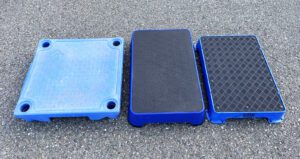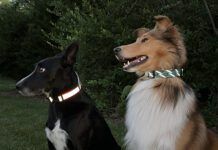Many trainers use a platform or a box, also called a “place board,” to help a dog understand the concept of remaining in a designated spot. In the beginning stage of training, the dog is encouraged to step onto the platform or box, either with a food lure or toy, and reinforced whenever his feet come into contact with the platform. Reinforcement stops or is withheld when the dog steps off the platform. The difference in the sensations of stepping or being on and stepping or being off the platform helps create bright-line criteria – for both the handler and the dog – of what will be reinforced and what will not.
Most dogs quickly start volunteering to step onto the dog training platform more frequently and remaining there for longer periods of duration – which the handler continues to reinforce with food treats. Then the handler can start using cues and reinforcement to shape the specific behaviors she wants from the dog.
Behaviors that can be easily taught using a dog training place board include:
- Stand/Stay
- Sit/Stay
- Down/Stay
- Back Up (dog is encouraged to step onto the platform with his back feet only)
- “Front” (a behavior that is used in obedience competition, requiring the dog to come directly to the handler and sit very straight close to and in front of the handler)
- “Return to Heel” (again, used in obedience competitions, requiring the dog to leave the front position, walk clockwise around/behind the handler to a position at the handler’s left side, i.e., the “heel” position)
- “Side” or “Swing Finish” (another obedience move where the dog pivots counter-clockwise from a front position to the heel position on the handler’s left side)
To start teaching each of these behaviors, the platform is placed in the goal location (relative to the handler) and the dog is lured or shaped into the desired position, and reinforced for reaching that location, going to the location on cue, remaining in that location on cue, and eventually, going to and remaining in a certain position in that location on cue.
Denise Fenzi, founder of Fenzi Dog Sports Academy, an online school dedicated to providing high-quality instruction for competitive dog sports, frequently uses platforms when training her dogs. “I use them because it’s black and white for the dog,” she says. “It’s easier at first for them to learn Stay by staying on the platform as opposed to staying in an undefined spot on the ground. The same attribute makes place boards hard to beat for teaching the dog precision work – where the dog needs to be in a very specific position.”
Fenzi has another tip about using platforms to work on the “Stay” behavior. She often “sends” her dogs to a place board from a distance, rather than positioning them on the platform and then walking away. This way, the act of walking away doesn’t predict a recall or draw the dog off the platform to follow the handler.
Dog Training Platforms for Fitness

You can also use a dog training platform to lead your dog through exercises that will build his fitness, coordination, and flexibility. Veterinary physical therapy or fitness instructors often use dog training platforms to encourage the dog to step up and down and to perform certain stretches in a slow, controlled manner.
Cato Outdoors, maker of the Cato Board dog training platform, has a collection of videos that show you how a platform can be used for dog fitness exercises here.
Best Dog Training Platforms
There are three companies that make place boards for dog training:
Blue-9 is the maker of a platform it calls the KLIMB, a 24” by 24” training platform that can be used without legs for a height of 4 inches, with optional short legs (set of four sold separately) for a height of 6 inches, or with the standard (included) legs for a height of 12 inches. KLIMBS can be attached to other Klimbs to create larger platforms, and can even be stacked securely to create taller platforms. $160. Blue-9 offers a very good (and free!) guide to teaching your dog to use a platform. It can be downloaded from the Blue-9 Resource Library; click on KLIMB Training Quick Start Guide.

Whole Dog Journal is reader-supported. If you purchase through links on our site we may earn a commission. Whole Dog Journal does not accept money for its food and product reviews.
The next two dog training platforms are rectangular, which helps dogs hold their position (being narrower, it’s harder for a dog to turn around while staying on the board):
Cato Outdoors makes the Cato Board, which comes in two sizes, 11 different colors, and can be ordered with either a rubber non-slip surface or an artificial turf surface. The original board measures 24” by 16”, is 3.5 inches tall, weighs 7.7 lbs, and costs $79. Very large or long dogs might be better served by the Cato Board XL, which is 36” by 12” inches and 3.5 inches tall; it sells for $95.
Huntmark’s Dog Training Place Board is available in dark blue or “optic yellow.” It measures 28” by 18” and is 4.5 inches high. It can support up to 200 pounds, and has non-skid rubber feet and a raised rubber traction surface. It weighs 8 lbs 11 oz. $86.






Thank you for this article. I see fellow trainers using these. (I suspect it’s because they are all Fenzi followers.) I’ve been using rugs, towels, or similar, familiar, items for my students for many decades. Platforms can be prohibitively expensive for my students and not practical in most home situations. Dogs perceive the textures and handlers can see them, plus they are familiar to both. along with the commands in the article, I use them to demonstrate how to name items. They are also useful targets for early shaping exercises where dogs are given more rewards for being entirely on the rug, and for then offering a Sit or Down. Rugs/towels/ bed targets are welcome at home when owners need the dog to stay in one place, for example, while cooking dinner or entertaining visitors (versus the dogs jumping all over them). Cloth targets are also easier for short learners, like 4-H kids, as they dogs are less likely to tower over them. Please keep up the great articles! ❤